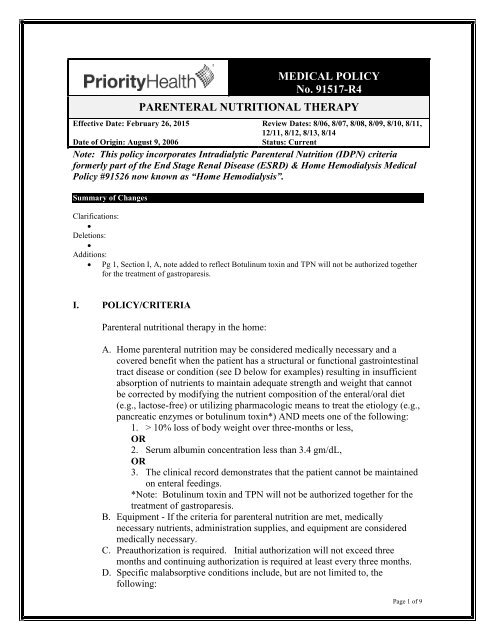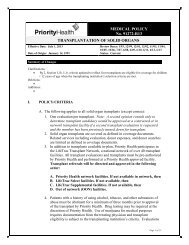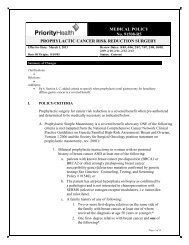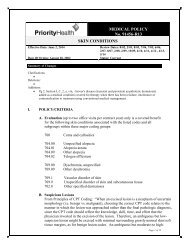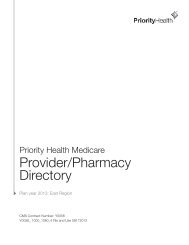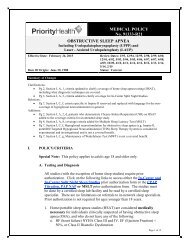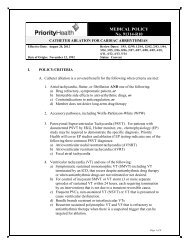Parenteral Nutrition Therapy in the Home - 91517 - Priority Health
Parenteral Nutrition Therapy in the Home - 91517 - Priority Health
Parenteral Nutrition Therapy in the Home - 91517 - Priority Health
You also want an ePaper? Increase the reach of your titles
YUMPU automatically turns print PDFs into web optimized ePapers that Google loves.
MEDICAL POLICYNo. <strong>91517</strong>-R4PARENTERAL NUTRITIONAL THERAPYEffective Date: February 26, 2015 Review Dates: 8/06, 8/07, 8/08, 8/09, 8/10, 8/11,12/11, 8/12, 8/13, 8/14Date of Orig<strong>in</strong>: August 9, 2006Status: CurrentNote: This policy <strong>in</strong>corporates Intradialytic <strong>Parenteral</strong> <strong>Nutrition</strong> (IDPN) criteriaformerly part of <strong>the</strong> End Stage Renal Disease (ESRD) & <strong>Home</strong> Hemodialysis MedicalPolicy #91526 now known as “<strong>Home</strong> Hemodialysis”.Summary of ChangesClarifications:•Deletions:•Additions:• Pg 1, Section I, A, note added to reflect Botul<strong>in</strong>um tox<strong>in</strong> and TPN will not be authorized toge<strong>the</strong>rfor <strong>the</strong> treatment of gastroparesis.I. POLICY/CRITERIA<strong>Parenteral</strong> nutritional <strong>the</strong>rapy <strong>in</strong> <strong>the</strong> home:A. <strong>Home</strong> parenteral nutrition may be considered medically necessary and acovered benefit when <strong>the</strong> patient has a structural or functional gastro<strong>in</strong>test<strong>in</strong>altract disease or condition (see D below for examples) result<strong>in</strong>g <strong>in</strong> <strong>in</strong>sufficientabsorption of nutrients to ma<strong>in</strong>ta<strong>in</strong> adequate strength and weight that cannotbe corrected by modify<strong>in</strong>g <strong>the</strong> nutrient composition of <strong>the</strong> enteral/oral diet(e.g., lactose-free) or utiliz<strong>in</strong>g pharmacologic means to treat <strong>the</strong> etiology (e.g.,pancreatic enzymes or botul<strong>in</strong>um tox<strong>in</strong>*) AND meets one of <strong>the</strong> follow<strong>in</strong>g:1. > 10% loss of body weight over three-months or less,OR2. Serum album<strong>in</strong> concentration less than 3.4 gm/dL,OR3. The cl<strong>in</strong>ical record demonstrates that <strong>the</strong> patient cannot be ma<strong>in</strong>ta<strong>in</strong>edon enteral feed<strong>in</strong>gs.*Note: Botul<strong>in</strong>um tox<strong>in</strong> and TPN will not be authorized toge<strong>the</strong>r for <strong>the</strong>treatment of gastroparesis.B. Equipment - If <strong>the</strong> criteria for parenteral nutrition are met, medicallynecessary nutrients, adm<strong>in</strong>istration supplies, and equipment are consideredmedically necessary.C. Preauthorization is required. Initial authorization will not exceed threemonths and cont<strong>in</strong>u<strong>in</strong>g authorization is required at least every three months.D. Specific malabsorptive conditions <strong>in</strong>clude, but are not limited to, <strong>the</strong>follow<strong>in</strong>g:Page 1 of 9
MEDICAL POLICYNo. <strong>91517</strong>-R4<strong>Parenteral</strong> <strong>Nutrition</strong>al <strong>Therapy</strong>• Crohn's disease• Newborn <strong>in</strong>fants with catastrophic gastro<strong>in</strong>test<strong>in</strong>al anomalies such astracheoesophageal fistula, gastroschisis, omphalocele, or massive<strong>in</strong>test<strong>in</strong>al atresia• Infants and young children who fail to thrive due to short bowelsyndrome, malabsorption, or chronic idiopathic diarrhea• Short bowel syndrome secondary to massive small bowel resection• Prolonged paralytic ileus after major surgery or multiple <strong>in</strong>juries• Radiation enteritis• Chronic or severe acute pancreatitis when a feed<strong>in</strong>g tube cannot beplaced or tube feed<strong>in</strong>g is not tolerated• Hyperemesis Gravidarum (severe hyperemesis dur<strong>in</strong>g pregnancy)when a feed<strong>in</strong>g tube cannot be placed or tolerated.• Obstruction secondary to stricture or neoplasm of <strong>the</strong> esophagus orstomach, where a feed<strong>in</strong>g tube cannot be placed beyond <strong>the</strong>obstruction• Small bowel obstruction that cannot be bypassed by a feed<strong>in</strong>g tube• Malabsorption due to enterocolic, enterovesical, or enterocutaneousfistulas (parenteral nutrition be<strong>in</strong>g temporary until <strong>the</strong> fistula isrepaired)• Motility disorder (pseudo-obstruction)E. <strong>Home</strong> <strong>in</strong>travenous parenteral nutrition is considered not medically necessaryand not a covered benefit, <strong>in</strong>clud<strong>in</strong>g but not limited to <strong>the</strong> follow<strong>in</strong>gcircumstances:1. To <strong>in</strong>crease prote<strong>in</strong> or caloric <strong>in</strong>take <strong>in</strong> addition to <strong>the</strong> patient’s dailydiet2. For rout<strong>in</strong>e pre- and/or postoperative care3. Patients with functional GI tracts <strong>in</strong>clud<strong>in</strong>g but not limited to <strong>the</strong>follow<strong>in</strong>g:a. Disorders that <strong>in</strong>duce anorexia <strong>in</strong>clud<strong>in</strong>g cancerb. Swallow<strong>in</strong>g disordersc. A temporary defect <strong>in</strong> gastric empty<strong>in</strong>g such as a metabolic orelectrolyte disorder.d. A psychological disorder impair<strong>in</strong>g food <strong>in</strong>take such asdepression or anorexia nervosa.e. A physical disorder impair<strong>in</strong>g food <strong>in</strong>take such as dyspnea ofsevere pulmonary or cardiac disease.f. A side effect of a medicationg. Renal failure or dialysis.F. Intradialytic <strong>Parenteral</strong> <strong>Nutrition</strong> (IDPN)1. Intradialytic parenteral nutrition (IDPN) will be covered for ESRD* ifmember has a serum album<strong>in</strong> < 33.4 g/dl or prote<strong>in</strong> < 6 g/dl and one of<strong>the</strong> follow<strong>in</strong>g:Page 2 of 9
MEDICAL POLICYNo. <strong>91517</strong>-R4<strong>Parenteral</strong> <strong>Nutrition</strong>al <strong>Therapy</strong>a. BMI < 18.5 kg/m2 orb. Un<strong>in</strong>tentional weight loss > 10% with<strong>in</strong> last 6 months orc. BMI < 20 kg/m2 and un<strong>in</strong>tentional weight loss >5% with<strong>in</strong> last3-6 months*cl<strong>in</strong>ical re-evaluation after six months for consideration of cont<strong>in</strong>uedtreatmentII.MEDICAL NECESSITY REVIEWRequiredNot RequiredNot ApplicableIII.APPLICATION TO PRODUCTSCoverage is subject to member’s specific benefits. Group specific policy willsupersede this policy when applicable. HMO/EPO: This policy applies to <strong>in</strong>sured HMO/EPO plans. POS: This policy applies to <strong>in</strong>sured POS plans. PPO: This policy applies to <strong>in</strong>sured PPO plans. Consult <strong>in</strong>dividual plan documents asstate mandated benefits may apply. If <strong>the</strong>re is a conflict between this policy and a plandocument, <strong>the</strong> provisions of <strong>the</strong> plan document will govern. ASO: For self-funded plans, consult <strong>in</strong>dividual plan documents. If <strong>the</strong>re is a conflictbetween this policy and a self-funded plan document, <strong>the</strong> provisions of <strong>the</strong> plan documentwill govern. INDIVIDUAL: For <strong>in</strong>dividual policies, consult <strong>the</strong> <strong>in</strong>dividual <strong>in</strong>surance policy. If <strong>the</strong>re isa conflict between this medical policy and <strong>the</strong> <strong>in</strong>dividual <strong>in</strong>surance policy document, <strong>the</strong>provisions of <strong>the</strong> <strong>in</strong>dividual <strong>in</strong>surance policy will govern. MEDICARE: Coverage is determ<strong>in</strong>ed by <strong>the</strong> Centers for Medicare and Medicaid Services(CMS); if a coverage determ<strong>in</strong>ation has not been adopted by CMS, this policy applies. MEDICAID/HEALTHY MICHIGAN PLAN: For Medicaid/<strong>Health</strong>y Michigan Planmembers, this policy will apply. Coverage is based on medical necessity criteria be<strong>in</strong>g metand <strong>the</strong> appropriate code(s) from <strong>the</strong> cod<strong>in</strong>g section of this policy be<strong>in</strong>g <strong>in</strong>cluded on <strong>the</strong>Michigan Medicaid Fee Schedule located at: http://www.michigan.gov/mdch/0,1607,7-132-2945_42542_42543_42546_42551-159815--,00.html. If <strong>the</strong>re is a discrepancy betweenthis policy and <strong>the</strong> Michigan Medicaid Provider Manual located at:http://www.michigan.gov/mdch/0,1607,7-132-2945_5100-87572--,00.html, <strong>the</strong> MichiganMedicaid Provider Manual will govern. For Medical Supplies/DME/Pros<strong>the</strong>tics andOrthotics, please refer to <strong>the</strong> Michigan Medicaid Fee Schedule to verify coverage. MICHILD: For MICHILD members, this policy will apply unless MICHILD certificate ofcoverage limits or extends coverage.Page 3 of 9
MEDICAL POLICYNo. <strong>91517</strong>-R4<strong>Parenteral</strong> <strong>Nutrition</strong>al <strong>Therapy</strong>IV.DESCRIPTION<strong>Parenteral</strong> <strong>Nutrition</strong> (PN)<strong>Parenteral</strong> nutrition (or PN) is <strong>the</strong> provision of nutritional requirements<strong>in</strong>travenously, ei<strong>the</strong>r through a central or peripheral ve<strong>in</strong>. The purpose of<strong>in</strong>itiat<strong>in</strong>g parenteral nutritional <strong>the</strong>rapy is to prevent or correct specific nutrientdeficiencies and to prevent <strong>the</strong> adverse effects of malnutrition when <strong>the</strong>gastro<strong>in</strong>test<strong>in</strong>al tract cannot be used effectively or safely.Generally, <strong>the</strong> parenteral approach is considered medically necessary only ifadequate nutritional <strong>in</strong>take is not possible via <strong>the</strong> oral or tube-feed<strong>in</strong>g route.A daily caloric <strong>in</strong>take for adults of 20-40kcal/kg is generally sufficient to ma<strong>in</strong>ta<strong>in</strong>body weight. If less than 20-30kcal/kg per day it may be consideredsupplemental.<strong>Parenteral</strong> nutritional <strong>the</strong>rapy is covered as def<strong>in</strong>ed above for patients with severepathology of <strong>the</strong> alimentary tract that does not allow absorption of sufficientnutrients to ma<strong>in</strong>ta<strong>in</strong> weight and strength commensurate with <strong>the</strong> patient's generalcondition.Intradialytic <strong>Parenteral</strong> <strong>Nutrition</strong> (IDPN) for ESRDIn use s<strong>in</strong>ce <strong>the</strong> 1970s, <strong>in</strong>tradialytic parenteral nutrition (IDPN) is a convenientmethod of adm<strong>in</strong>ister<strong>in</strong>g nutritional supplements to patients undergo<strong>in</strong>ghemodialysis for end-stage renal disease (ESRD). Malnutrition is common <strong>in</strong>patients with ESRD due to factors such as poor eat<strong>in</strong>g habits and loss of nutrientsdur<strong>in</strong>g dialysis. Ma<strong>in</strong>ta<strong>in</strong><strong>in</strong>g adequate nutrition <strong>in</strong> patients undergo<strong>in</strong>ghemodialysis is vital, as a number of nutritional parameters are associated with<strong>in</strong>creased mortality, <strong>in</strong>clud<strong>in</strong>g low body fat, fat loss over time, low body mass<strong>in</strong>dex (BMI) (< 20 kg/m2), reduced serum album<strong>in</strong> levels, and reduced creat<strong>in</strong><strong>in</strong>elevels. In <strong>the</strong> 1980s, a trend began <strong>in</strong> which decisions regard<strong>in</strong>g <strong>the</strong> use of IDPN<strong>in</strong> <strong>the</strong> United States were empirically based, and, although this was controversial,IPDN ga<strong>in</strong>ed approval through <strong>the</strong> Centers for Medicaid & Medicare Services asa Medicare-covered benefit. As IDPN use expanded, <strong>the</strong> <strong>in</strong>creas<strong>in</strong>g use andassociated costs attracted scrut<strong>in</strong>y, due to <strong>the</strong> limited evidence base that supportedIDPN use. Accord<strong>in</strong>gly, <strong>in</strong> 1994, Medicare coverage of IDPN was tightened and<strong>the</strong>n fur<strong>the</strong>r restricted <strong>in</strong> 1996, which resulted <strong>in</strong> a decl<strong>in</strong>e <strong>in</strong> its use. Severalmanufacturers produce premixed bags for IDPN, or components of a formulationcan be made up on site from previously prepared <strong>in</strong>gredients. IDPN formulasgenerally conta<strong>in</strong> a mix of am<strong>in</strong>o acids, carbohydrate (usually dextrose), andlipids. Trace elements and multivitam<strong>in</strong>s may also be <strong>in</strong>cluded. IDPN may beconsidered for hemodialysis patients who show physical wast<strong>in</strong>g and significantweight loss; have serum hypoalbum<strong>in</strong>emia (low album<strong>in</strong>) and/or o<strong>the</strong>r markers ofmalnutrition; have failed to respond to oral nutrition supplements; have failed, orPage 4 of 9
MEDICAL POLICYNo. <strong>91517</strong>-R4<strong>Parenteral</strong> <strong>Nutrition</strong>al <strong>Therapy</strong>are contra<strong>in</strong>dicated, for enteral feed<strong>in</strong>g; and whose caloric and/or prote<strong>in</strong> <strong>in</strong>take is<strong>in</strong>sufficient to meet recommended daily requirements. IDPN is given at <strong>the</strong> sametime as hemodialysis by a dialysis nurse or o<strong>the</strong>r licensed healthcare practitioner,at an outpatient center. IDPN is <strong>in</strong>fused through an exist<strong>in</strong>g dialysis accessca<strong>the</strong>ter or site, via an <strong>in</strong>fusion pump; no additional needle stick or l<strong>in</strong>e isnecessary.The results of three comparative retrospective studies suggest that IDPN forup to 1 year <strong>in</strong> duration may reduce mortality <strong>in</strong> malnourished patientsundergo<strong>in</strong>g hemodialysis. In contrast, <strong>the</strong> results of <strong>the</strong> s<strong>in</strong>gle prospectiverandomized study conducted <strong>in</strong> France, provide strong evidence that <strong>the</strong>re is noreduction <strong>in</strong>mortality for 1 year of IDPN plus oral nutritional supplementationcompared with oral nutritional supplementation alone. Despite <strong>the</strong> lack of strongevidence, IDPN is an established <strong>the</strong>rapy and it is possible that it offers potentialadvantages to a subset of malnourished patients <strong>in</strong> ESRD; however, prospectivestudies are needed to def<strong>in</strong>e <strong>the</strong>se subpopulations.V. CODINGICD-9 Diagnosis Codes:These diagnoses may support medical necessity (for dates of service on or beforeSeptember 30, 2015):263.9 Unspecified Prote<strong>in</strong>-Calorie Malnutrition536.3 Gastroparesis537.4 Fistula of stomach or duodenum555.0 – 555.9 Regional enteritis560.1 Paralytic ileus560.2 Volvulus560.81 Intest<strong>in</strong>al or peritoneal adhesions with obstruction(postoperative) (post<strong>in</strong>fection)560.89 Intest<strong>in</strong>al or peritoneal adhesions with obstruction, o<strong>the</strong>r560.9 Unspecified <strong>in</strong>test<strong>in</strong>al obstruction565.1 Anal fistula569.69 O<strong>the</strong>r complication of colostomy or enterostomy569.71 Pouchitis569.79 O<strong>the</strong>r complications of <strong>in</strong>test<strong>in</strong>al pouch569.81 Fistula of <strong>in</strong>test<strong>in</strong>e, exclud<strong>in</strong>g rectum and anus569.83 Perforation of Intest<strong>in</strong>e569.9 Unspecified Disorder of Intest<strong>in</strong>e579.3 O<strong>the</strong>r and Unspecified Postsurgical Nonabsorption579.8 O<strong>the</strong>r specified <strong>in</strong>test<strong>in</strong>al malabsorption579.9 Unspecified <strong>in</strong>test<strong>in</strong>al malabsorption643.10 – 643.13 Hyperemesis gravidarum with metabolic disturbance751.5 O<strong>the</strong>r congenital anomalies of <strong>in</strong>test<strong>in</strong>e777.50 – 777.53 Necrotiz<strong>in</strong>g enterocolitis <strong>in</strong> newbornPage 5 of 9
MEDICAL POLICYNo. <strong>91517</strong>-R4<strong>Parenteral</strong> <strong>Nutrition</strong>al <strong>Therapy</strong>998.6 Persistent postoperative fistula, not elsewhere classifiedICD-10 Codes that may apply (for dates of service on or after October 1, 2015):E08.43 Diabetes mellitus due to underly<strong>in</strong>g condition with diabeticautonomic (poly) neuropathyE09.43 Drug or chemical <strong>in</strong>duced diabetes mellitus with neurologicalcomplications with diabetic autonomic (poly)neuropathyE10.43 Type 1 diabetes mellitus with diabetic autonomic (poly)neuropathyE11.43 Type 2 diabetes mellitus with diabetic autonomic (poly)neuropathyE13.43 O<strong>the</strong>r specified diabetes mellitus with diabetic autonomic (poly)neuropathyE46Unspecified prote<strong>in</strong>-calorie malnutritionE64.0 Sequelae of prote<strong>in</strong>-calorie malnutritionK31.6 Fistula of stomach and duodenumK31.84 GastroparesisK31.89 O<strong>the</strong>r diseases of stomach and duodenumK50.00 - K50.919 Crohn's diseaseK51.0012 - K51.919 Ulcerative colitisK56.0 Paralytic ileusK56.2 VolvulusK56.5 Intest<strong>in</strong>al adhesions [bands] with obstruction (postprocedural)(post<strong>in</strong>fection)K56.60 Unspecified <strong>in</strong>test<strong>in</strong>al obstructionK56.69 O<strong>the</strong>r <strong>in</strong>test<strong>in</strong>al obstructionK56.7 Ileus, unspecifiedK60.3 Anal fistulaK60.4 Rectal fistulaK60.5 Anorectal fistulaK63.1 Perforation of <strong>in</strong>test<strong>in</strong>e (nontraumatic)K63.2 Fistula of <strong>in</strong>test<strong>in</strong>eK63.9 Disease of <strong>in</strong>test<strong>in</strong>e, unspecifiedK90.4 Malabsorption due to <strong>in</strong>tolerance, not elsewhere classifiedK90.89 O<strong>the</strong>r <strong>in</strong>test<strong>in</strong>al malabsorptionK90.9 Intest<strong>in</strong>al malabsorption, unspecifiedK91.2 Postsurgical malabsorption, not elsewhere classifiedK91.850 PouchitisK91.858 O<strong>the</strong>r complications of <strong>in</strong>test<strong>in</strong>al pouchK92.9 Disease of digestive system, unspecifiedK94.01 Colostomy hemorrhageK94.09 O<strong>the</strong>r complications of colostomyK94.11 Enterostomy hemorrhageK94.19 O<strong>the</strong>r complications of enterostomyO21.1 Hyperemesis gravidarum with metabolic disturbanceP77.1 – P77.9 Necrotiz<strong>in</strong>g enterocolitis <strong>in</strong> newbornQ43.0 – Q43.9 Q43.4 O<strong>the</strong>r congenital malformations of <strong>in</strong>test<strong>in</strong>eT81.83xA - T81.83xS Persistent postprocedural fistulaPage 6 of 9
MEDICAL POLICYNo. <strong>91517</strong>-R4<strong>Parenteral</strong> <strong>Nutrition</strong>al <strong>Therapy</strong>CPT/HCPCS Codes:Presence of codes on this list does not guarantee coverage.B4164 <strong>Parenteral</strong> nutrition solution: carbohydrates (dextrose), 50% or less (500 ml =1 unit), home mixB4168 <strong>Parenteral</strong> nutrition solution; am<strong>in</strong>o acid, 3.5%, (500 ml = 1 unit) - home mixB4172 <strong>Parenteral</strong> nutrition solution; am<strong>in</strong>o acid, 5.5% through 7%, (500 ml = 1 unit)- home mixB4176 <strong>Parenteral</strong> nutrition solution; am<strong>in</strong>o acid, 7% through 8.5%, (500 ml = 1 unit)- home mixB4178 <strong>Parenteral</strong> nutrition solution: am<strong>in</strong>o acid, greater than 8.5% (500 ml = 1 unit),home mixB4180 <strong>Parenteral</strong> nutrition solution: carbohydrates (dextrose), greater than 50% (500ml = 1 unit), home mixB4185B4189B4193B4197B4199B4216B4220B4222B4224B5000B5100B5200<strong>Parenteral</strong> nutrition solution, per 10 grams lipids<strong>Parenteral</strong> nutrition solution: compounded am<strong>in</strong>o acid and carbohydrateswith electrolytes, trace elements, and vitam<strong>in</strong>s, <strong>in</strong>clud<strong>in</strong>g preparation, anystrength, 10 to 51 g of prote<strong>in</strong>, premix<strong>Parenteral</strong> nutrition solution: compounded am<strong>in</strong>o acid and carbohydrateswith electrolytes, trace elements, and vitam<strong>in</strong>s, <strong>in</strong>clud<strong>in</strong>g preparation, anystrength, 52 to 73 g of prote<strong>in</strong>, premix<strong>Parenteral</strong> nutrition solution; compounded am<strong>in</strong>o acid and carbohydrateswith electrolytes, trace elements and vitam<strong>in</strong>s, <strong>in</strong>clud<strong>in</strong>g preparation, anystrength, 74 to 100 grams of prote<strong>in</strong> - premix<strong>Parenteral</strong> nutrition solution; compounded am<strong>in</strong>o acid and carbohydrateswith electrolytes, trace elements and vitam<strong>in</strong>s, <strong>in</strong>clud<strong>in</strong>g preparation, anystrength, over 100 grams of prote<strong>in</strong> - premix<strong>Parenteral</strong> nutrition; additives (vitam<strong>in</strong>s, trace elements, Hepar<strong>in</strong>,electrolytes), home mix, per day<strong>Parenteral</strong> nutrition supply kit; premix, per day<strong>Parenteral</strong> nutrition supply kit; home mix, per day<strong>Parenteral</strong> nutrition adm<strong>in</strong>istration kit, per day<strong>Parenteral</strong> nutrition solution: compounded am<strong>in</strong>o acid and carbohydrateswith electrolytes, trace elements, and vitam<strong>in</strong>s, <strong>in</strong>clud<strong>in</strong>g preparation, anystrength, renal - Amirosyn RF, NephrAm<strong>in</strong>e, RenAm<strong>in</strong>e - premix<strong>Parenteral</strong> nutrition solution: compounded am<strong>in</strong>o acid and carbohydrateswith electrolytes, trace elements, and vitam<strong>in</strong>s, <strong>in</strong>clud<strong>in</strong>g preparation, anystrength, hepatic - FreAm<strong>in</strong>e HBC, HepatAm<strong>in</strong>e - premix<strong>Parenteral</strong> nutrition solution: compounded am<strong>in</strong>o acid and carbohydrateswith electrolytes, trace elements, and vitam<strong>in</strong>s, <strong>in</strong>clud<strong>in</strong>g preparation, anystrength, stress - branch cha<strong>in</strong> am<strong>in</strong>o acids - premixB9004B9006E0791A4211<strong>Parenteral</strong> <strong>Nutrition</strong> Infusion Pump, Portable<strong>Parenteral</strong> <strong>Nutrition</strong> Infusion Pump, Stationary<strong>Parenteral</strong> <strong>in</strong>fusion pump, stationary, s<strong>in</strong>gle or multichannelSupplies for self-adm<strong>in</strong>istered <strong>in</strong>jections(Per diem “S” codes <strong>in</strong>clude payment for TPN solution, standard additives, supplies andequipment)Page 7 of 9
MEDICAL POLICYNo. <strong>91517</strong>-R4<strong>Parenteral</strong> <strong>Nutrition</strong>al <strong>Therapy</strong>S9364S9365S9366S9367S9368<strong>Home</strong> <strong>in</strong>fusion <strong>the</strong>rapy, total parenteral nutrition (TPN); adm<strong>in</strong>istrativeservices, professional pharmacy services, care coord<strong>in</strong>ation, and all necessarysupplies and equipment <strong>in</strong>clud<strong>in</strong>g standard TPN formula (lipids, specialtyam<strong>in</strong>o acid formulas, drugs o<strong>the</strong>r than <strong>in</strong> standard formula and nurs<strong>in</strong>g visitscoded separately), per diem<strong>Home</strong> <strong>in</strong>fusion <strong>the</strong>rapy, total parenteral nutrition (TPN); 1 liter per day,adm<strong>in</strong>istrative services, professional pharmacy services, care coord<strong>in</strong>ation,and all necessary supplies and equipment <strong>in</strong>clud<strong>in</strong>g standard TPN formula(lipids, specialty am<strong>in</strong>o acid formulas, drugs o<strong>the</strong>r than <strong>in</strong> standard formulaand nurs<strong>in</strong>g visits coded separately), per diem<strong>Home</strong> <strong>in</strong>fusion <strong>the</strong>rapy, total parenteral nutrition (TPN); more than 1 liter butno more than 2 liters per day, adm<strong>in</strong>istrative services, professional pharmacyservices, care coord<strong>in</strong>ation, and all necessary supplies and equipment<strong>in</strong>clud<strong>in</strong>g standard TPN formula (lipids, specialty am<strong>in</strong>o acid formulas, drugso<strong>the</strong>r than <strong>in</strong> standard formula and nurs<strong>in</strong>g visits coded separately), per diem<strong>Home</strong> <strong>in</strong>fusion <strong>the</strong>rapy, total parenteral nutrition (TPN); more than 2 litersbut no more than 3 liters per day, adm<strong>in</strong>istrative services, professionalpharmacy services, care coord<strong>in</strong>ation, and all necessary supplies andequipment <strong>in</strong>clud<strong>in</strong>g standard TPN formula (lipids, specialty am<strong>in</strong>o acidformulas, drugs o<strong>the</strong>r than <strong>in</strong> standard formula and nurs<strong>in</strong>g visits codedseparately), per diem<strong>Home</strong> <strong>in</strong>fusion <strong>the</strong>rapy, total parenteral nutrition (TPN); more than 3 litersper day, adm<strong>in</strong>istrative services, professional pharmacy services, carecoord<strong>in</strong>ation, and all necessary supplies and equipment <strong>in</strong>clud<strong>in</strong>g standardTPN formula (lipids, specialty am<strong>in</strong>o acid formulas, drugs o<strong>the</strong>r than <strong>in</strong>standard formula and nurs<strong>in</strong>g visits coded separately), per diemVI.REFERENCES1. “<strong>Nutrition</strong>al Support”, Aetna Cl<strong>in</strong>ical Policy Bullet<strong>in</strong>, February 2005.Available on <strong>the</strong> World Wide Web @http://www.aetna.com/cpb/data/CPBA0061.html (Retrieved December 15,2005)2. “<strong>Parenteral</strong> <strong>Nutrition</strong>; <strong>Home</strong> and Intradialytic” Regence Blue Cross GroupMedical Policy December 2003. Available on <strong>the</strong> World Wide Web @http://www.regence.com/trgmedpol/allied<strong>Health</strong>/ah06.html (RetrievedDecember 15, 2005)3. “<strong>Home</strong> Total <strong>Parenteral</strong> <strong>Nutrition</strong>” Blue Cross Blue Shield of MassachusettsMedical Policy, May 2005. Available on <strong>the</strong> World Wide Web @http://www.bluecrossma.com/common/en_US/medical_policies/fs296.htm(Retrieved December 15, 2005)4. “Enteral and <strong>Parenteral</strong> <strong>Nutrition</strong> <strong>Therapy</strong>”, Medicare National CoverageDecision. Available on <strong>the</strong> World Wide Web @http://www.cms.hhs.gov/mcd/viewncd.asp?ncd_id=180.2&ncd_version=1&basket=ncd%3A180%2E2%3A1%3AEnteral+and+<strong>Parenteral</strong>+<strong>Nutrition</strong>al+<strong>Therapy</strong> (Retrieved December 15, 2005Page 8 of 9
MEDICAL POLICYNo. <strong>91517</strong>-R4<strong>Parenteral</strong> <strong>Nutrition</strong>al <strong>Therapy</strong>5. Adm<strong>in</strong>aStar Federal, Inc (Region B), Local coverage Determ<strong>in</strong>ation (LCD#L5063), <strong>Parenteral</strong> <strong>Nutrition</strong>, CMS Pub. 100-3 (National CoverageDeterm<strong>in</strong>ations Manual), chapter 1, section 180.2, Orig<strong>in</strong>al determ<strong>in</strong>ationeffective date: 10/01/1993, Revision effective date 01/01/2007.6. Hayes Brief, Hayes, Inc. Intradialytic <strong>Parenteral</strong> <strong>Nutrition</strong> (IDPN) for End-StageRenal Disease <strong>in</strong> Adults, August 2008.AMA CPT Copyright Statement:All Current Procedure Term<strong>in</strong>ology (CPT) codes, descriptions, and o<strong>the</strong>r data are copyrighted by <strong>the</strong>American Medical Association.This document is for <strong>in</strong>formational purposes only. It is not an authorization, certification, explanation ofbenefits, or contract. Receipt of benefits is subject to satisfaction of all terms and conditions of coverage.Eligibility and benefit coverage are determ<strong>in</strong>ed <strong>in</strong> accordance with <strong>the</strong> terms of <strong>the</strong> member’s plan <strong>in</strong> effectas of <strong>the</strong> date services are rendered. <strong>Priority</strong> <strong>Health</strong>’s medical policies are developed with <strong>the</strong> assistanceof medical professionals and are based upon a review of published and unpublished <strong>in</strong>formation <strong>in</strong>clud<strong>in</strong>g,but not limited to, current medical literature, guidel<strong>in</strong>es published by public health and health researchagencies, and community medical practices <strong>in</strong> <strong>the</strong> treatment and diagnosis of disease. Because medicalpractice, <strong>in</strong>formation, and technology are constantly chang<strong>in</strong>g, <strong>Priority</strong> <strong>Health</strong> reserves <strong>the</strong> right to reviewand update its medical policies at its discretion...<strong>Priority</strong> <strong>Health</strong>’s medical policies are <strong>in</strong>tended to serve as a resource to <strong>the</strong> plan. They are not <strong>in</strong>tended tolimit <strong>the</strong> plan’s ability to <strong>in</strong>terpret plan language as deemed appropriate. Physicians and o<strong>the</strong>r providersare solely responsible for all aspects of medical care and treatment, <strong>in</strong>clud<strong>in</strong>g <strong>the</strong> type, quality, and levelsof care and treatment <strong>the</strong>y choose to provide.The name “<strong>Priority</strong> <strong>Health</strong>” and <strong>the</strong> term “plan” mean <strong>Priority</strong> <strong>Health</strong>, <strong>Priority</strong> <strong>Health</strong> Managed Benefits,Inc., <strong>Priority</strong> <strong>Health</strong> Insurance Company and <strong>Priority</strong> <strong>Health</strong> Government Programs, Inc.Page 9 of 9


